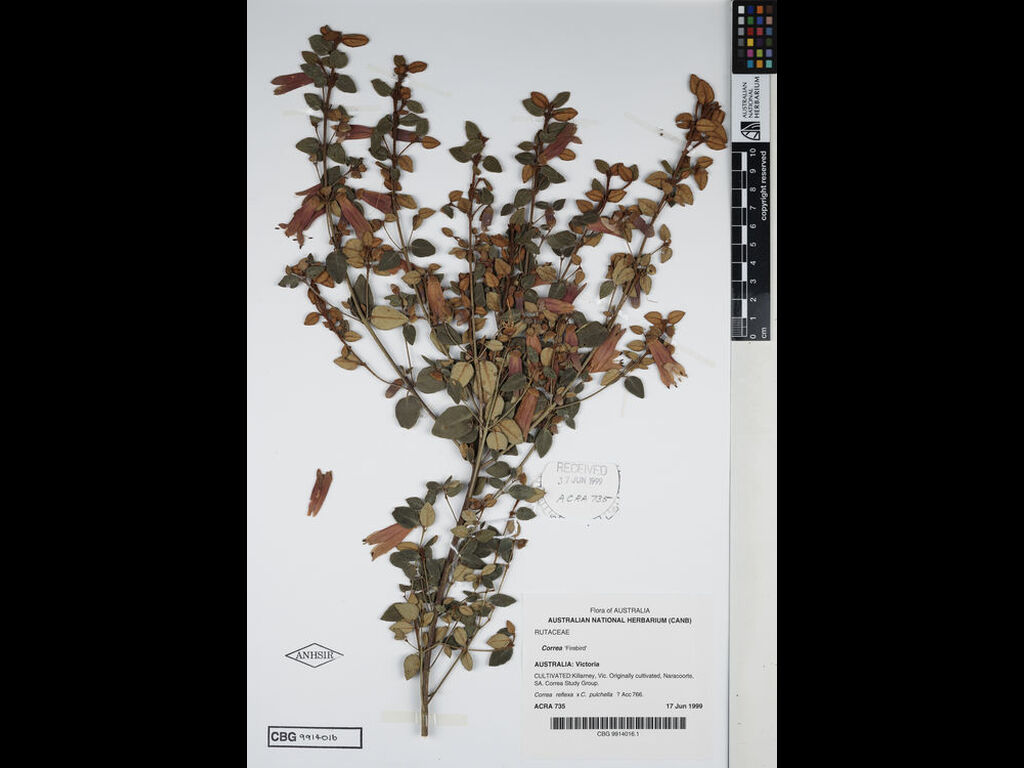Correa 'Firebird'
- File Number
- 766
- ACRA Field Book Number
- 735
- Registration Date
- 19/01/2007
- Application Received
- 17/06/1999
- Family
- Rutaceae
- Cultivar Name
- Correa 'Firebird'
- Origin
- This cultivar originated a s a seedling in the garden of Marion Beek, Naracoorte, South Australia in 1990. It may be a hybrid between C. reflexa and C. pulchella. The name refers to the colour of the flower. The applicant is Ms Cherree Densley on behalf of the ASGAP Correa Study Group. Application received by ACRA 17th June 1999.
- Characteristics
- Compact shrub to c. 1 m x 2 m with a dense habit. Branchlets tomentose with rust-coloured stellate hairs. Simple cordate leaves, almost deltoid, 25 mm x 15 nun, shortly petiolate. Leaf apices obtuse to acute, leaf bases cordate, venation reticulate, margins with rust-coloured stellate hairs. Upper surfaces of mature leaves dark green and scabridulous with occasional stellate hairs. Upper surfaces of young leaves minutely densely tomentose with white stehate hairs and occasional rust-coloured stellate hairs, becoming more concentrated at margins. Lower surfaces minutely densely tomentose with white stellate hairs and scattered rust-coloured stellate hairs becoming more concentrated on the veins. No evidence of calycices, pedicels or bracteoles on this non-flowering specimen. Corolla cylindrical 30 mm x 10 mm, deep red-orange. Peak flowering is from May to July in most districts. Diagnosis: The leaves of this cultivar conform to descriptions for C. reflexa var reflexa. The flower has an affinity to C. pulchella because of its uniform red-orange colour. No further diagnosis can be made until a flower is examined for relationships. The cultivar is distinctive because of its size which is larger than most C. pulchella flowers and because of its colour which is different from other C. reflexa x C. pulchella hybrids, e.g., C. 'Dusky Bells', C. 'Pink Mist', C. 'Mannii'.
- Cultivation
- This cultivar is fast-growing in cultivation. It is frost and drought hardy and has a compact growth habit. The large and prolific red-orange flowers which appear in late Autumn are an attractive feature of the plant. It is easy to grow from cuttings and is bird attractive. This form would be suited to most garden conditions. It is lime tolerant and responds favourably to light pruning. It would suit rockeries and foreground planting in garden beds.
- Publication
- Hitchcock, M. (2003), Descriptions of the Species, Varieties and Cultivars. Australian Plants 22(174): 36
- Colour Coding
- RHS Colour Chart 1995 Flowers: 47A, tips 182B Leaves upper surface: 139A Leaves lower surface: 195B
- Propagation
- Cuttings from semi-firm new growth most of the year
- Applicant Name
- Cherree Densley on behalfof the ASGAP Correa Study Group.
- Uses
- As part of a mass planting or mixed in a shrubbery, or as a feature plant. Attracts nectar feeding birds.
- Availability
- Kuranga Nursery
- ANBG Accession Numbers
- ACC766, ACRA735, CBG9914016
- NSL ID
- -

